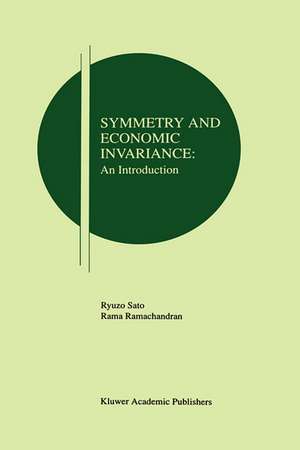Symmetry and Economic Invariance: An Introduction: Research Monographs in Japan-U.S. Business and Economics, cartea 3
Autor Ryuzo Sato, Rama V. Ramachandranen Limba Engleză Hardback – 30 noi 1997
| Toate formatele și edițiile | Preț | Express |
|---|---|---|
| Paperback (2) | 633.19 lei 6-8 săpt. | |
| Springer Us – 13 oct 2012 | 633.19 lei 6-8 săpt. | |
| Springer – 23 aug 2016 | 640.06 lei 6-8 săpt. | |
| Hardback (2) | 639.25 lei 6-8 săpt. | |
| Springer Us – 30 noi 1997 | 639.25 lei 6-8 săpt. | |
| Springer – 19 dec 2013 | 646.30 lei 6-8 săpt. |
Preț: 639.25 lei
Preț vechi: 752.06 lei
-15% Nou
Puncte Express: 959
Preț estimativ în valută:
122.31€ • 127.72$ • 101.01£
122.31€ • 127.72$ • 101.01£
Carte tipărită la comandă
Livrare economică 15-29 aprilie
Preluare comenzi: 021 569.72.76
Specificații
ISBN-13: 9780792380436
ISBN-10: 0792380436
Pagini: 134
Ilustrații: VIII, 134 p.
Dimensiuni: 155 x 235 x 10 mm
Greutate: 0.39 kg
Ediția:1998
Editura: Springer Us
Colecția Springer
Seria Research Monographs in Japan-U.S. Business and Economics
Locul publicării:New York, NY, United States
ISBN-10: 0792380436
Pagini: 134
Ilustrații: VIII, 134 p.
Dimensiuni: 155 x 235 x 10 mm
Greutate: 0.39 kg
Ediția:1998
Editura: Springer Us
Colecția Springer
Seria Research Monographs in Japan-U.S. Business and Economics
Locul publicării:New York, NY, United States
Public țintă
ResearchCuprins
1. Introduction.- 1.1 Group Theory and Classification of Mathematical Structure.- 1.2 Lie Groups and Invariance.- 1.3 Economic Applications of Lie Groups.- 2. Technical Progress and Economies of Scale.- 2.1 A Reformulation of the Problem.- 2.2 Lie Groups.- 2.3 Holotheticity.- 2.4 Conclusion.- 3. Holothetic Production Functions.- 3.1 Types of Technical Progress Functions and Holotheticity.- 3.2 Marginal Rate of Transformation and Extended Transformation.- 3.3 Holotheticity and Lie Bracket.- 3.4 Conclusion.- 4. Utility and Demand.- 4.1 Integrability Conditions.- 4.2 Conclusion.- 5. Duality and Self Duality.- 5.1 Duality in consumer theory.- 5.2 Separability and Additivity.- 5.3 Self-Duality in Demand Theory.- 5.4 A Method of Deriving Self-Dual Demand Functions.- 5.5 Empirical Estimation of Self-Dual Demand Functions.- 5.6 Implicit Self-Duality of Production and Cost Functions.- 5.7 Conclusion.- 6. The Theory of Index Numbers.- 6.1 Statistical approach.- 6.2 Test Approach.- 6.3 Economic Index Numbers.- 6.4 Divisia Index.- 7. Dynamics and Conservation Laws.- 7.1 The Variational Problem and the Ramsey Rule.- 7.2 Steady State and the Golden Rules.- 7.3 The Hamiltonian Formulation and Control Theory.- 7.4 Noether Theorem and Its Implications.- 7.5 Conservation Laws in von Neumann Model.- 7.6 Measurement of National Income and Income-Wealth Ratios.- 7.7 Conclusion.- 8. Bibliography.
Recenzii
From the book reviews:
“The monograph provides an introduction to the application of group theory, a mathematical tool, to examine the structure of economic models. … It will be useful for postgraduate students and researches specializing in dynamical models of economics.” (Sergei Georgievich Zhuravlev, zbMATH, Vol. 1291, 2014)
“The monograph provides an introduction to the application of group theory, a mathematical tool, to examine the structure of economic models. … It will be useful for postgraduate students and researches specializing in dynamical models of economics.” (Sergei Georgievich Zhuravlev, zbMATH, Vol. 1291, 2014)
Notă biografică
Ryuzo Sato
Ryuzo Sato is C.V. Starr Professor Emeritus of Economics at the Stern School of Business, New York University. He was director of the Center for Japan–U.S. Business and Economic Studies at the Stern School. Prior to becoming a Stern faculty member, he was a professor of economics at Brown University. Professor Sato also taught at Harvard University, The University of Tokyo, Kyoto University, and Bonn University. He was the founding chief editor of Japan and the World Economy, an international theory and policy journal.
For more than 40 years, Professor Sato has divided his time between Japan and the USA, and he conducts research, gives lectures, and writes on the subject of Japan–US relations.
Recent work includes Biased Technical Change and Economic Conservation Laws (Springer, 2006), Growth Theory and Technical Change: The Selected Essays of Ryuzo Sato, vol. 1 (Edward Elgar, 1996), Production, Stability and DynamicSymmetry: The Selected Essays of Ryuzo Sato, vol. 2 (Edward Elgar, 1999), and Theory of Technical Change and Economic Invariance: Application of Lie Groups (Academic Press, 1981; reprint, new version, Edward Elgar, 1999). Professor Sato also writes columns regularly for several Japanese newspapers.
Professor Sato, who was a Fulbright Scholar, received his B.A. in economics and his Dr. Economics from Hitotsubashi University in Tokyo, and his Ph.D. in economics from Johns Hopkins University. His principal areas of research interest are mathematical economics and economic growth.
Rama V.Ramachandran
Rama V.Ramachandran received his master’s degree from Madras University, India, and his Ph.D. from Brown University in the U.S.A. He was a faculty member of the Department of Economics of Southern Methodist University and the Department of Economics of the Stern School of Business, New York University. He was associate director of the Center for Japan–U.S. Business and Economics at the Stern School. His research interests were in microeconomics and growth theory. After retirement, he has focused on economic pedagogy and authored an innovative introduction to microeconomics, Opportunities and Choices: Understanding Our Economic Decisions. (http://www.visualeconomicanalysis.info/index.html)
Ryuzo Sato is C.V. Starr Professor Emeritus of Economics at the Stern School of Business, New York University. He was director of the Center for Japan–U.S. Business and Economic Studies at the Stern School. Prior to becoming a Stern faculty member, he was a professor of economics at Brown University. Professor Sato also taught at Harvard University, The University of Tokyo, Kyoto University, and Bonn University. He was the founding chief editor of Japan and the World Economy, an international theory and policy journal.
For more than 40 years, Professor Sato has divided his time between Japan and the USA, and he conducts research, gives lectures, and writes on the subject of Japan–US relations.
Recent work includes Biased Technical Change and Economic Conservation Laws (Springer, 2006), Growth Theory and Technical Change: The Selected Essays of Ryuzo Sato, vol. 1 (Edward Elgar, 1996), Production, Stability and DynamicSymmetry: The Selected Essays of Ryuzo Sato, vol. 2 (Edward Elgar, 1999), and Theory of Technical Change and Economic Invariance: Application of Lie Groups (Academic Press, 1981; reprint, new version, Edward Elgar, 1999). Professor Sato also writes columns regularly for several Japanese newspapers.
Professor Sato, who was a Fulbright Scholar, received his B.A. in economics and his Dr. Economics from Hitotsubashi University in Tokyo, and his Ph.D. in economics from Johns Hopkins University. His principal areas of research interest are mathematical economics and economic growth.
Rama V.Ramachandran
Rama V.Ramachandran received his master’s degree from Madras University, India, and his Ph.D. from Brown University in the U.S.A. He was a faculty member of the Department of Economics of Southern Methodist University and the Department of Economics of the Stern School of Business, New York University. He was associate director of the Center for Japan–U.S. Business and Economics at the Stern School. His research interests were in microeconomics and growth theory. After retirement, he has focused on economic pedagogy and authored an innovative introduction to microeconomics, Opportunities and Choices: Understanding Our Economic Decisions. (http://www.visualeconomicanalysis.info/index.html)
Textul de pe ultima copertă
Symmetry and Economic Invariance (second enhanced edition) explores how the symmetry and invariance of economic models can provide insights into their properties. Although the professional economist of today is adept at many of the mathematical techniques used in static and dynamic optimization models, group theory is still not among his or her repertoire of tools. The authors aim to show that group theoretic methods form a natural extension of the techniques commonly used in economics and that they can be easily mastered. Part I provides an introduction that minimizes prerequisites including prior knowledge of group theory. Part II discusses recent developments in the field.
Caracteristici
Demonstrates how group theory provides insights into the dynamics and the equilibriums of economic models Provides an introduction to group theory for economists, assuming no prior knowledge Presents a simple characterization of the equilibrium path of dynamic models



















